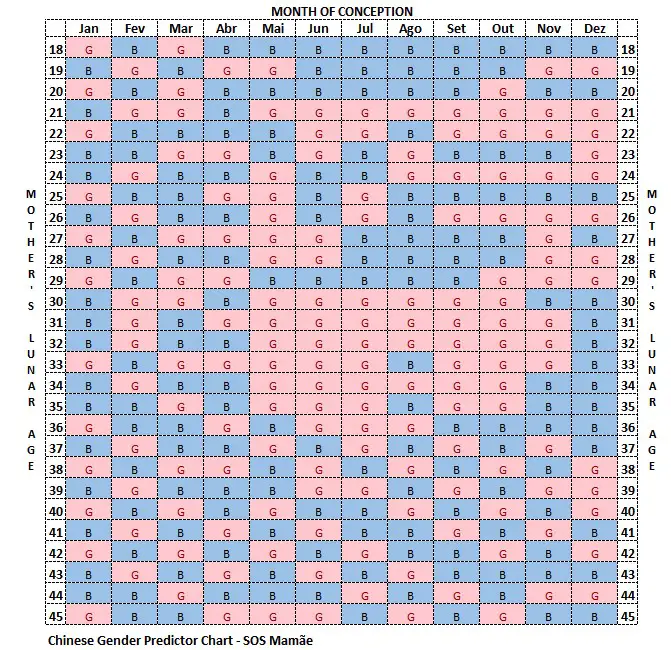Discover the baby’s gender with the Chinese Gender Predictor Chart 2024!
The Chinese Gender Predictor Chart, also known as the Baby Gender Predictor Calendar, has the primary purpose of calculating the baby’s gender.
It is an age-old tradition that has increasingly piqued the interest of many expectant mothers around the world.
However, it is important to note that there is no scientific basis to prove that the Chinese Chart actually works.
In this blog post, in addition to calculating the baby’s gender through the Chinese Gender Predictor Chart (2024), we will explore different aspects related to the Chart. We will investigate its fascinating history, understand how it works, and assess its credibility based on scientific studies conducted on the subject.
Content
- Baby Gender Calculator
- History of the Chinese Gender Predictor Chart or Calendar
- How the Chinese Gender Predictor Chart Works (2024)
- Popularity of the Chinese Gender Predictor Chart Worldwide
- Can I Trust the Chinese Gender Predictor Chart?
- Fetal Sex Determination Test
- Ultrasound
- FAQ
Baby Gender Calculator
Use the Baby Gender Calculator, based on the Chinese Gender Predictor Chart (2024), to find out whether your baby will be a boy or a girl.
Remember that the Chinese Pregnancy Chart Calculator is just a fun way to try to guess the baby’s gender and has no scientific validation.
Fill in the fields below and find out the baby’s gender.
History of the Chinese Gender Predictor Chart or Calendar
The history of the Chinese Gender Predictor Chart dates back centuries, with its roots deeply intertwined with Chinese culture.
There are several versions regarding the origin of the Chinese Chart. One claims that the Chinese Chart was found stored in an ancient royal tomb.
It is a practice that combines elements of Chinese philosophy, the lunar calendar, and divination traditions.
Its foundations are linked to the belief that the mother’s lunar age and the month of conception can predict the baby’s gender.
Chinese philosophy, notably Taoism and Confucianism, played a significant role in the conception of the Chinese Chart. Additionally, the connection with the lunar calendar reflects the importance the Chinese attribute to observing the cosmos in their daily practices.
Over the centuries, this practice has been passed down from generation to generation, adapting to different regions of China. Each community added its own nuances to the chart, incorporating local traditions and specific rituals.
How the Chinese Gender Predictor Chart Works (2024)
The operation of the Chinese Gender Predictor Chart (2024) revolves around the mother’s lunar age, which is calculated according to the Chinese calendar. This calendar differs from the Western solar calendar, taking into account the moon phase at the time of birth.
To calculate the mother’s lunar age, simply add 1 year to her age (according to the Western calendar). However, if the woman was born in January or February, no additional number needs to be added.
By crossing the mother’s lunar age with the month of conception on a specific table, it is possible to predict the baby’s gender. Each cell in the table corresponds to a unique combination of lunar age and month, indicating whether the baby will be a boy or a girl.
To better understand, see the Chinese Chart below.

Imagine a woman with a lunar age of 30 at the time of conception and conception occurring in May. By locating the intersection of these two factors on the table, you can calculate the predicted gender of the baby and determine it as female.
Popularity of the Chinese Gender Predictor Chart Worldwide
With information spreading worldwide at high speed, the Chinese Gender Predictor Chart has transcended borders and become a global phenomenon.
Many expectant mothers from various parts of the world have adopted this tradition as part of their pregnancy journey.
Social media played a crucial role in popularizing this chart. The practice went viral, with many sharing their experiences and even organizing gender reveal parties based on the chart.
Although the Chinese Chart is often seen as a serious cultural tradition, the contemporary approach often regards it lightly, incorporating it into events and celebrations in playful and relaxed ways.
Can I Trust the Chinese Gender Predictor Chart?
It is crucial to understand that the Chinese Gender Predictor Chart is more of a cultural tradition than a scientific tool. Its popularity lies in the combination of symbolic elements and rituals deeply rooted in Chinese culture.
Despite its widespread acceptance in many communities, the accuracy of the Chinese Chart is often questioned by healthcare professionals.
Scientific studies have been conducted to evaluate its effectiveness, and many of them point to variable and, in some cases, inconsistent results.
A Swedish study aimed at examining the influence of the lunar cycle on the child’s gender concluded that there is no scientific basis for determining that the lunar calendar can interfere with the baby’s gender.
Examining a sample of 2.8 million women between 1973 and 2006, it was found that the accuracy rate of the Chinese Chart was 50%. In other words, the same as randomly guessing the baby’s gender.
Fetal Sex Determination Test
If you want to know the baby’s gender with a scientifically based test, there is the fetal sex determination test.
This test is a blood test that analyzes fetal DNA present in the mother’s blood.
The test identifies sex chromosomes to determine whether the baby is male or female.
The Fetal Sex Determination Test is advised from the 8th week of gestation when a sufficient amount of fetal DNA can be found in the mother’s blood.
Ultrasound
Ultrasound is one of the most reliable and common ways to find out the baby’s gender during pregnancy.
Usually, between the 15th and 16th weeks of pregnancy, it is possible to know the baby’s gender. However, if the doctor has not been able to identify the child’s sex securely by then, in the second morphological ultrasound, performed approximately in the 20th week, it is possible to identify the gender more easily.
It is important to note that the accuracy of the ultrasound in determining the baby’s gender depends on various factors, including the quality of the equipment, the experience of the professional, and the fetus’s position during the exam.
Overall, the accuracy rate is quite high, especially in the intermediate stages of pregnancy.






